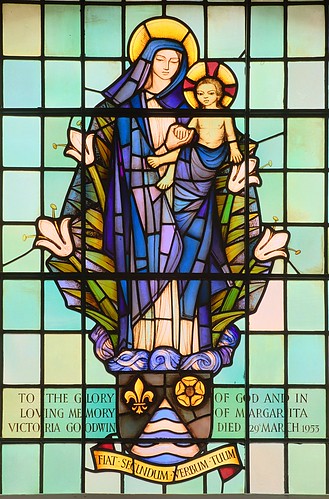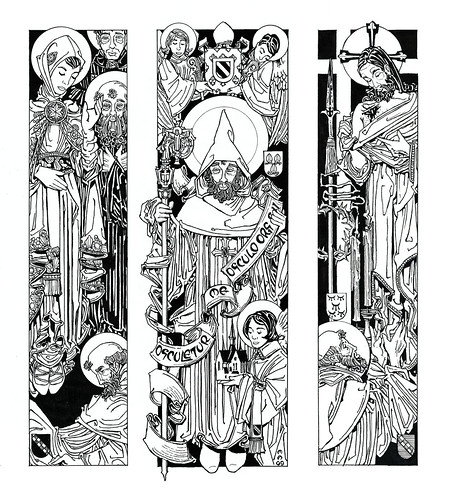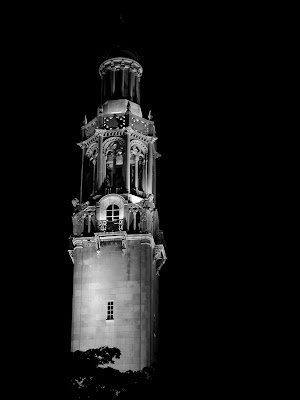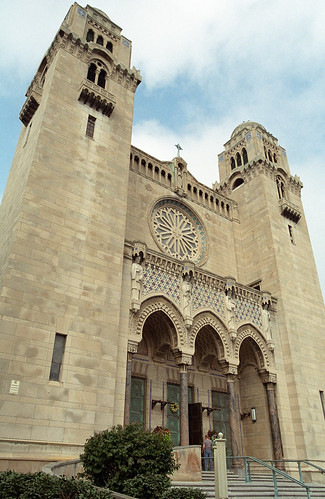Friday, August 28
Welcome, John Sonnen Fans!

I wanted to welcome our readers coming from Orbis Catholicus. I am sorry if it has been, in terms of the subject matter of my postings, a rather architecturally sparse week, but this will remedy that. John has always been a tremendous supporter of my work, and I owe him a great deal for the opportunities his support has opened up for me. Certainly if anyone has any questions about church architecture and ecclesiastical design work, please, don't hesitate to contact me at the email on the sidebar. The firm I work for has been very excited about such projects.
Some of my design work--an extensive set of new furnishings for a restored century-old cathedral in Vladivostok, Russia including a 40-foot-high organ case/altarpiece and a rose-colored marble altar--was featured last year in Catholic World Report, and can also be read about here. You may also enjoy my writing on architectural subjects in our archives, or over at the New Liturgical Movement (one of the other group weblogs I write for), where I do a great deal of my aesthetic thinking-out-loud. I also have a number of pdfs of articles I have written on the subject (including original illustrations and designs by me) for journals like the scholarly Antiphon and St. Austin Review that I would be happy to share.
In the mean time, you might enjoy this article I wrote discussing my thesis project design for a seminary I did while I was attending the School of Architecture at Notre Dame, and for which I won the Rambusch Prize for Religious Architecture. It can be found here at the site of the literary journal Dappled Things, which is also available in a print version. One illustration from it is shown above and two more follow below.


Cookie Monster versus Waiting for Godot
Wednesday, August 26

A rather charming bit of modern (if not quite modernistic) stained glass from St. Mary-le-bone, London. (Source.)
In Re: New Jersey/Albania
Two hundred years later, some Indians said Manhattan meant "where we all got drunk"...Though let's bear in mind he says it's a fanciful etymology, even if it does explain a whole lot.
--Stewart, Names on the Land, p. 68
As a Former Manhattanite, This Amuses Me
--Introduction by Matt Weiland to George R. Stewart's Names on the Land
Tuesday, August 25
Catholic Cleveland: Historic Church Saved, But Others Still in Danger
I received some correspondence some months back about a number of potential parish closings--as many as fifty-two--in the diocese of Cleveland. The most potentially tragic of these cases was the stunning St. Ignatius of Antioch parish (above), an opulent and eclectic structure in the Romanesque style with a number of elements that are faintly Mozarabic. (Incidentally, the Mozarabs' Italian cousins, so to speak, pop up later on in this story). Its slender campanile looms strikingly over the surrounding neighborhood. Fortunately it, and the turn-of-the-century neo-Baroque St. Colman's were recently saved from being shuttered, and the parishes will remain open. This was a great relief as I had not been able to turn my attention to this problem until this week. Unfortunately, the other parishes are still going to be merged and there is no answer yet on what will happen to the structures.
Palermo Comes to Ohio
This is particularly disconcerting with regards to the truly amazing and unique church of St. James in Lakewood (below), a gilded jewel-box done in the Sicilian Gothic style, strongly reminiscent of the cathedral in Monreale and the Palatine chapel in Palermo. (Some of our readers may recall the significant role the church architecture of this remarkable little island has played in the work of several prominent Gothic revival architects, most notably the English Sir Ninian Comper. To see it pop up unexpectedly in the American Midwest is nothing short of a wonder.) As far as I know, it is the only example of this unusual style in the United States, or at the least, one of the very few, and one of the very best. This story here is somewhat out-of-date, as it mentions St. Ignatius and St. Colman, but it does include photos of some of the other forty-nine churches, including the astonishing St. James, which deserves to be preserved, if only for its exceptional singularity and opulence. And one never knows when a neighborhood may turn around.
Lost Opportunities
Meanwhile, the diocese is breaking ground on a $3 million, 450-seat church in the exurb of Grafton, Our Lady Queen of Peace (below), done in a dismal retro style. As I have said before, this is an aesthetic that even most thorough-going neo-modernistic contemporary architects have moved away from. In some ways, I appreciate the fact the diocese is still building churches where churches are needed to be built. Some parish closings may be an inevitable fact of life given the way the populace in the last four or so decades in many cities. It is important for people to remember that Catholics are, in terms of per-capita income, one of the richest denominations in the country. Yet we are parsimonious givers when it comes to the collection basket. Parish closings like this are an opportunity to rectify this image, and take responsibility once again.
That being said, there are also historical and aesthetic issues that are often simply ignored in these cases. Beautiful landmarks like St. James deserved to be preserved, if only for their historic merit; they spring from a staggering flowering of American imagination that came, almost out of nowhere, at the turn of the last century, a period only now just beginning to be understood, reappraised, and treasured for the renaissance it was.
Some creativity is called for. Parishes cannot be turned around overnight, and I recognize that empty churches have to be put to use somehow. Dioceses have to run on a shoestring budget these days. Organizations like the Canons Regular of St. John Cantius and the Institute of Christ the King, like the Anglican "slum ritualists" of the nineteenth century, have shown beauty can flower again in the most unlikely places. And even where that is impossible--there are only so many priests like that to go round at this point in time--there is the remarkable, and I would believe, very doable notion of simply picking the church up and dropping it down somewhere else where it will get a proper home.
Less than a century ago, an entire monastery in Spain was taken to bits and mailed to California, where it ended up in one of William Randolph Hearst's warehouses. (He had planned to turn the chapel into a gigantic cruciform swimming pool, but the plan came to nought). I believe an order of monks is currently trying to put the whole thing back together like a gigantic jigsaw puzzle. We have also reported on the financially reasonable proposal to take the beautiful and historic St. Gerald's Church in rather moribund Buffalo to bits and reassemble it in Norcross, Georgia, where new parishes are growing at a remarkable rate, at considerably less than the cost of building a new traditional church. Interestingly enough, this odyssey was estimated at only $3 million, exactly the cost of the new church of Our Lady of Peace. One assumes moving, say, St. James out of downtown to a Cleveland exurb would presumably require even less effort.
As to that new parish church, I am glad it is comparatively small--only 450 seats--given the monstrous, unwieldy megachurch size of most suburban parishes, and I am quite pleased to hear that it has received a fairly reasonable budget. $3 million may sound lavish, but it is, given the cost of building, just right, or even a bit on the tight side. What disappoints me is that it is being designed in an unremarkable and rather outmodeled modern style, when one could easily get a fairly austere but handsome traditional-style church for the same budget.

Monday, August 24
[Humor] Rejected Titles for Our Lady
Aviatrix of All Graces: Pius XII's lame pun would have gotten stuck in as an appendix to his declaration of Our Lady's Assumption, attempted to co-opt enthusiasm for the title of Mediatrix of All Graces and turn things down a notch, and would also have provided a handy patron for airline stewardesses, who had to make due with flying visits from the then-still-living Padre Pio when they entered his airspace. Unfortunately, while the test-groups responded well to the new icons of the Virgin wearing a flight helmet and goggles, they couldn't figure out why a) Amelia Earhart had been canonized and b) why she was wearing a light blue bathrobe. The whole thing was eventually recycled as a subplot on one episode of The Flying Nun.
Our Lady of Perpetual Motion: While a favorite of Jesuit weird scientist Athanasius Kircher, the scientific basis behind this title was disproved in 1616 by a series of experiments by Galileo which involved dropping the visiting Isaac Newton from the belltower of Pisa cathedral and seeing if he bounced. It was later unsuccessfully resurrected in 1997 by the bishops of Connecticut as a devotion for overworked soccer moms. (See below, Our Mother of Soccer.) The only church dedicated under this title was turned into a disco in late 2001. It has not changed its name.
Our Lady of Spain: The patroness of the shortlived Carlist Heavy Concertina Regiment in the Spanish Civil War, the title had to be retired after the League of Nations banned the use of the accordion as a combat weapon in 1939.
Our Lady of the Most Holy Trinity: While a popular devotion, and one still going very strong, what is forgotten is the disastrous attempt by the reunited St. Louis Jesuits to introduce a reworked "Once, Twice, Three Times a Lady," as the introit of her feastday in 1979, under the claim that it was a simpler way of expressing Our Lady's differing spiritual relationships to the members fo the Godhead. This led to the disastrous and shortlived "Motown Records Interdict" of 1980, the less said of which the better. It has since been repurposed as the sequence for the feast of the Three Maries.
The Immaculate Fifteen to Twenty Minutes or Possibly Three or Four Days After Conception: St. Thomas Aquinas did not know how to come up with snappy concepts for his theological positions. Fortunately Blessed Duns Scotus knew a bit about advertising.
Our Lady of the Nap: Better known as the Feast of Our Lady's Dormition in the Byzantine church.
Our Mother of Soccer: Traditionally depicted wearing Marian-blue mom jeans, a once-nice cardigan covered in child-sized food-stains, in one hand a white orb covered in black hexagons (the significance remains obscure), in the other a Ziploc bag of celery sticks for the kids, and under her feet a minivan. This is not to be confused with Our Lady, Queen of All Homeschoolers, where she is wearing a denim jumper, the soccer ball is replaced by a sheaf of lesson plans, and minivan is a bit larger.
Our Lady of Notre Dame: Actually, I think there really is a chapel dedicated to this tautology at my old alma mater, but they may have changed the name to something a bit more sensible.
Sunday, August 23
Our Lady, Swashbuckler
The one downside is I suspect the word "adventuress" is not translated properly from the Spanish as the word always suggests to me more Irene Adler and less Amelia Earhart. Ick.
Villancico VI for the Feast of the Assumption, 1676 (excerpt)
Clear the way for the entrance
of the bold adventuress
who undoes injustice,
who smashes insults.
The sun's rays are her
resplendent armor
the stars her helmet,
the moon her boots.
On her shining shield
with which she dazzles hell,
a mountain is emblazoned
and golden letters: Tota Pulchra.
Celebrated for her beauty,
feared for her ferocity
she is jaunty and valiant,
and angelic is her beauty...
She dispelled the charms
of the ancient serpent
whose conspiracy
sets us under slavery's yoke.
She avenges wrongs
and annuls unjust laws,
gives refuge to orphans
and shelter to widows.
She liberated prisoners
from that prison where,
were it not for her daring spirit,
still they'd await their release.
All hell trembles at the mere
mention of her name.
And they say its very kings
fast on her vigil...
She is the one, whose tread
no demon can endure.
When he sees her feet,
he takes to his heels.
Crowned with glory and honor,
the deeds that brought her fame,
since they cannot be contained on earth,
send her riding out of this world.
As knight errant of the spheres
on a new adventure,
she finds hidden treasure
sought by so many.
--Sor Juana Inés de la Cruz (1648-1695)
Matthew versus the Cathedral

I imagine some of our readers may remember the string of articles I wrote over at the NLM a little under a year ago concerning the proposed design for Saskatoon Cathedral, which also featured a number of counter-proposals. This massive project ($28 million Canadian) is being done in a somewhat old-fashioned modernistic style and on a liturgical plan that completely ignores the return to tradition so pithily encapsulated in the writings of Pope Benedict and made manifest in recent building projects too numerous to mention. Even some of the more disappointing cathedrals that have been built recently--Houston and Oakland come to mind, though for very different reasons--have at least made good-faith nods towards more a orthodox liturgical layout.
However, fundraising continues apace, and as a consequence, I was interviewed by the Saskatoon Star Phoenix to discuss my disappointment with the proposal. Even if the brevity of the article did not allow all my comments to make the cut, I am grateful for the opportunity to offer a dissenting opinion. An excerpt:
Four donations of $1 million and several $500,000 and $250,000 contributions have helped speed up the $28.5-million project through a fundraising campaign that began a little less than two years ago.(I am reminded of the Jubilee Church in Rome, a rather unimpressive postmodern structure whose costs were five times as much as the original budget. Modernism does not come cheap.)
While one Catholic blogger has called the design "St. Jetson and All Rockets, or Our Lady of the Crashed Millenium Falcon," the project's chief fundraiser says the design was a result of "tireless" collaboration among members of the church community.
The design is reflective of where the Saskatoon diocese is culturally, said Don Gorsalitz, director of development for the Roman Catholic Diocese of Saskatoon.
"We wanted to build a cathedral that was relevant to who we are as a faith community today," Gorsalitz said.
In 2008, Wisconsin-based writer and architect Matthew Alderman devised an alternate Gothic-style design on his Sacred Architecture blog at the Catholic website New Liturgical Movement.
Alderman believes younger Catholics are moving toward traditional design and cites the direction of Pope Benedict XVI, who advocates a return to tradition in art and liturgy.
"His vision is shared by an increasing number of architects, artists and clergy. Nearly all young adult Catholics I have encountered share this desire to reconnect with our common heritage. Here is the true cutting edge," Alderman said in an e-mail.
Gorsalitz said the "retro" design proposed by Alderman wouldn't be popular with the community in Saskatoon.
"If we built a cathedral that looked like that, we'd be criticized for building something that looked so backwards in time," Gorsalitz said.
"Some prefer a more Gothic-looking cathedral, but that's not who we are culturally."
Construction costs have doubled since the project was initially devised, with an anticipated budget now of $28.5 million.
I will simply comment there is a difference between "retro" and timeless, and that a design indebted to the work of a very small handful of twentieth-century European theorists (themselves largely superseded by the architectural crowd in favor today--postmodern, deconstructionist and whatever it is Zaha Hadid does) might be even more rightly called "retro" as well. And I suspect, based on emails I have received and blog postings that have appeared elsewhere, that in Saskatchewan there are at least a few folks who are equally dissatisfied as I am with the Cathedral's design. We can do better than this for God.

For more on my earlier counter-proposal, see here.
Saturday, August 15
The Liturgical Clip Art Gnomes Strike Again
Bishop Fabian Bruskewitz (Lincoln): My question has to do — I’m not
sure if it’s in order — with the publication. When all this is
finished, who decides the artwork that goes into the Missal? The
reason I say that is because the Sacramentaries we have now have some
childish stick men and silliness in there. And the old Missals had
some beautiful woodcuts and other sorts of things.
Is it the committee or the body of bishops? Who decides the artwork
that’s going to go into the ultimate publication? I don’t know if that
question is in order.
Bishop Serratelli: My understanding is that the publishers decide
that. [Some groaning and laughter].
Ya know, this could be fixed. (COUGH).

Friday, August 14
FOX may be surprised, but we're not.
Fox4KC.com: INDEPENDENCE, MO. - It's a story that sounds like a movie plot, or even a joke. But, it's very serious. A pair of nuns chased down an armed robbery suspect and helped police put the handcuffs on him.And in other tales of nuns with grit and guts, the USCCB has announced that Interrupted Lives, a documentary on Catholic sisters under post-WWII Communist regimes will be airing next month (9/13) on local ABC stations.
You can call it an act of God, or divine intervention. But, whatever you call it, one thing is clear: you don't mess with nuns from the Sisters of Saint Francis.
A typical morning at the Saint Francis of Holy Eucharist Convent at 24 Highway and Noland Road in Independence turned out to be anything but typical.
"We looked out window and saw someone in the bean field," said Sister Connie. "I thought it was someone hunting. He was dragging something with him."
Sister Connie soon realized the man was not on a mission from God.
"He kept coming across the field...I saw he had a gun in hands, what I thought was a rifle, and he dropped it in the field," said Sister Connie.
Not a man of the cloth, but a gun toting, tool wielding suspect who police think is responsible for two other burglaries in the area. Little did he know, his crime spree would soon be over.
"Sister Catrina started chasing him on foot," Sister Connie told us. Sister Catarina was just wearing flip flops on her feet. But, she took off after the man.
"I chased him behind the green house...I caught him again," said Sister Catarina.
Eventually he got away, but not for long. The story ended with the suspect in handcuffs.
"He could have harmed us and he didn't. Instead he chose to run, that tells me something about this young man," said Sister Connie.
When asked, the sisters said they hope the man will learn to change his ways after all of this. Of course, it's now up to the prosecutors office if charges will be filed.
More Photos of St. Joseph's, La Crosse

Br. Stephen, O.Cist., was kind enough to point me in the direction of his other, really fine photos of this remarkable modernized Gothic cathedral. Some samples are reproduced below.




(This triptych is strongly reminiscent of a similar work at the interesting transitional modernized colonial church of SS. Faith, Hope and Charity in the suburbs north of Chicago.)
Wednesday, August 12
Modernized Gothic: St. Joseph's Cathedral, La Crosse

I am unsure of the provenance of this photo (it may have come from the excellent Br. Stephen over at Sub Tuum), but it is a great view of a particularly interesting Liturgical Movement-era design, St. Joseph's Cathedral in La Crosse, Wisconsin, which is both well-planned liturgically and intriguing and mostly successful, if somewhat idiosyncratic, stylistically. This view is facing back across the altar towards the nave. Note the hanging corona.
Saturday, August 8
In Re: Venice
--Judith Martin, No Vulgar Hotel: The Desire and Pursuit of Venice, p. 91
Friday, August 7
Items of Clerical Vesture that Sound Like Types of Pasta or Other Sorts of Italian Food
2. Ferraiolone (Could be the flat layers of pasta that go into a lasagna)
3. Greca (it probably involves anchovies and pesto)
4. Soprana (actually, this sounds less like Italian food and more like someone with an Uncle Tucci who sleeps with the fishes)
5. Tabarro (Chicken al tabarro on a bed of fresh spinach hand-picked by Protonotaries Apostolic)
6. Zuchetto (Hand-made whole-wheat ravioli stuffed with fresh zuchetto, in a cream sauce a la Propaganda Fide)
Soutane, on the other hand, is clearly something involving garlic, snails, and French white wine.
Technically Permissible but Inappropriate Substitutes for the Mantilla
1. Doily
2. Baseball cap with "I (Heart) Hans Kung" on it
3. Black bandanna with skulls and crossbones (unless it's November 2)
4. Wig (unsuccessful marketing campaign: "The Stealth Mantilla.")
5. Balloon animal hat
6. Cardinal's galero
7. Hard hat with beer cans strapped to the sides.
8. Phrygian cap (1789 was a bad year)
9. Rubber Nixon mask (JFK might be permissible in some circles)
10. Spiked helmet (unless you are a girl Hohenzollern, and if so, my apologies.)
11. Lampshade
12. Ninja facemask
13. Urban Sombrero
14. Souvenir Statue of Liberty crown
15. Whatever that thing Subcommandante Marcos is always wearing
16. Man's toupee
17. Inverted tupperware container
18. Plastic shopping bag
19. Full-body gorilla costume.
20. Deep-sea diving bell
Also, if you have no hair, a mantilla is unnecessary: so please, no using double-sided tape to stick it to your baby's head.
Anything I missed?














